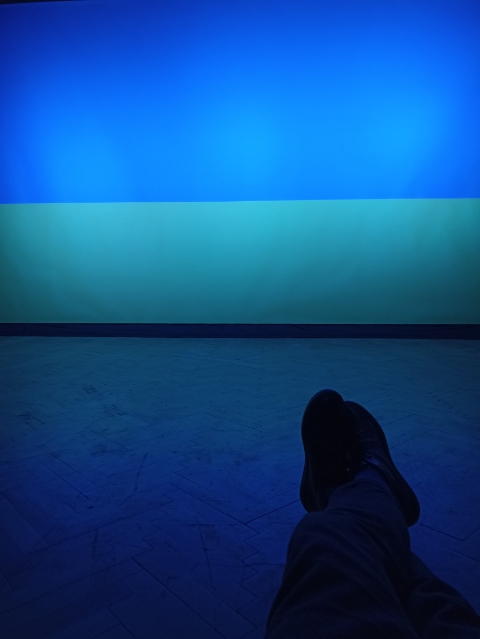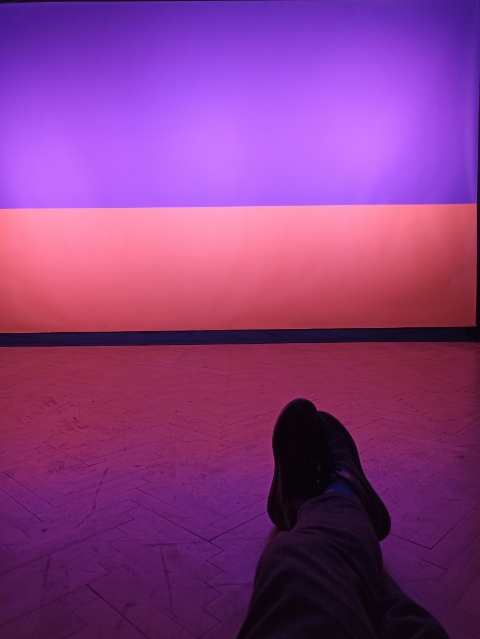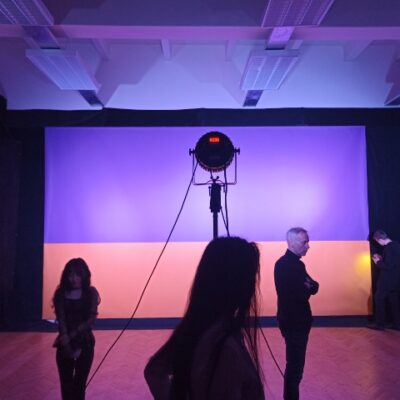View into the Void is not a view of the emptiness of existence, which according to the philosopher Martin Heidegger represents a state of abandonment (absence) of being ruled by the nihilist frenzy of unleashed technology and rigid metaphysics. Quite the opposite, in fact. Richard Loskot and Vítězslav Plavec’s View into the Void invites us on a dualistic, illusionistic journey of discovery in the form of gentle uncertainty on which we come to realize how easily how eyes can be fooled. We thus directly experience the relative nature of the visual world and the ambiguity of our entrenched sensory habits.
Each artist has created an original standalone installation, with each site-specific work made for the distinct and compelling atmosphere of the particular exhibition room. Vítězslav Plavec’s Supercoloured Landscape, a work of changing colours, has been installed in the Baroque baths of Experimental Space I, while Loskot’s View into the Void delves into the bowels of the Baroque basement of Experimental Space II. Though installed in different places, the two works have much in common. In terms of form, they share a minimalist style and an economical use of visual means. Several other common factors play an important role, including the physical qualities of light (intensity, colour, polarization) and the works’ processual nature, meaning the changing visual monochrome tones and the distinct accentuation of the horizon of the perceptual interface.
With Loskot, it is the interface between the material world of white light, which shines bewitchingly from the depths of the dark hallway, and its irrational reflection in the disturbed surface of the water, which surprisingly depicts a completely different scene than what we would expect. In its watery reflection, Loskot’s View into the Void reveals the imaginative movements of celestial bodies while projecting colourful, looped shadow-play of the shimmering sunrise and sunset. The installation makes us feel like we are witnessing a transcendental visual spectacle. In the watery mirror surface, the direct view of the illuminate white emptiness changes, with emptiness replaced by activity imitating the daily cycle.
By comparison, Plavec works with the horizon of the landscape. The monumental surface of the work, complementary violet and orange-yellow bands are divided into two fields in order to recall the boundary between sky and earth. The two-colour horizon is illuminated using three identical LED lights that slowly change in colour to produce unexpected colour changes on the surface of the work. This simulated situation presents us with a report on the changes to horizons under various lighting conditions. Commenting on the impermanence of Supercoloured Landscape, Plavec says: “It is at the boundary between sky and earth that we most frequently witness surprising phenomena. We have become so used to illusionistic reality that we know longer think about why objects have a different colour at noon and at night. The illusion of colour over the course of the day adds rhythm to our lives. And the roughly minute-long sequence of changing colour in my installation represents something like the colour cycle of the day.”
About the artists
Richard Loskot (1984, Most) studied visual communications at the Faculty of Art and Architecture of the Technical University of Liberec, where he currently teaches. His sophisticated work straddles the line between research and experimentation and involves a combination of architecture with sculpture and new technologies. Loskot is a founding member of the UAII art group, whose name stands for umění (art), architecture, intelligence and intervention – a reflection of his long-term interest in spatial work and a more comprehensive approach to space. Although he has been active on the art scene for just over a decade, in his meteoric career he has been honoured with a number of awards.
He is a three-time finalist for the Jindřich Chalupecký Award (2012, 2014, 2017), and in 2007 he won the Exit competition held by the Emil Filla Gallery in Ústí nad Labem. Loskot also frequently shows his work abroad (Biennale Monza; Rotor Gallery, Graz; Astrup Fearnley Museet, Oslo), and in 2013 he was a finalist for the Blumm Prize in Brussels.
Vítězslav Plavec (1996, Karlovy Vary) studied Environmental Design at Liberec Technical University’s Faculty of Art and Architecture, where he is currently continuing his studies under Richard Loskot. In 2019, he expanded his knowledge of architecture through a study exchange at the local art university in Penang, Malaysia. He began exhibiting just four years ago. His public installation Simulacra won the Neon Award at the 2021 Signal Festival.




